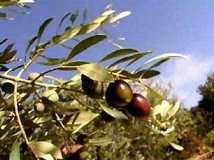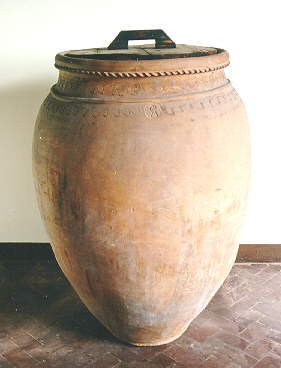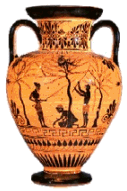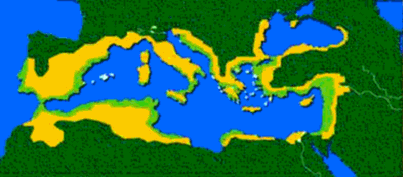|
Olive Farming
OLEA PRIMA OMNIUM ABORUM EST "Of all trees, the first is the Olive"
("DE RUSTICA" Giunio Moderato Columella - 1st century a.C.)
The origin of the olive tree (Olea europaea L.) is "lost in time, coinciding and mingling with the expansion of the Mediterranean civilizations which for centuries governed the destiny of mankind and left their imprint on Western culture.
|

|
|

In modern culture the word "oil" can surely derive from the Latin "oleum" and Greek "elaion", or from the ancient "ulu".
Olive leaf fossils hove been found in Pliocene deposits at Mongardino in Italy. Fossilised remains have been discovered in strata from the Upper Paleolithic at the Relilai snail hatchery in North Africa, and pieces of wild olive trees and stones have been uncovered in excavations of the Chalcolithic period and the Bronze Age in Spain. The existence of the olive tree therefore dates back to the twelfth millennium BC.
At the British Museum in London you can see the Vulci amphora (500 b.C.) where is represented a scene of olives harvesting.
|
Greek mythology describes a competition conducted by Zeus that would award patronage of Attica to the god or goddess who created the most useful gift. Poseidon gave the horse, powerful, swift and beautiful; Athena produced the olive tree, with its light-giving, soothing (and delicious) oil, welcome shade, and valuable wood, Athena became the patron of Attica, and her gift, the City Olive, was planted atop the Acropolis.
The olive branch and olive oil became symbolic of all that was good and noble in mankind and of permanence and perseverance. Playing a role in everyday activities, ceremonies and celebrations. On foot, travelers applied olive oil to their feet, people attending banquets wore olive wreaths and were anointed with olive oil infused with spices and aromatics…..victors at the Olympic Games were given oil in special lecythi.
Exodus 30:22-33 reads: "…the Lord spake unto Moses, saying, take thou also unto thee principal spices ... and ... olive oil.... And thou shalt make it ... a anointing oil."
…Noah's dove brought an emblem not only of peace, but of regeneration with its olive twig (a sign, too, for Christians, that prefigured the resurrection).

|
|
The wild olive tree originated in Asia Minor where it is extremely abundant and grows in thick forests. It appears to have spread from Syria to Greece via Anatolia (De Candolle, 1883) although other hypotheses point to lower Egypt, Nubia, Ethiopia, the Atlas Mountains or certain areas of Europe as its source area. Caruso for that reason believes it to be indigenous to the entire Mediterranean Basin and considers Asia Minor to have been the birthplace of the cultivated olive some six millennia ago. The Assyrians and Babylonians were the only ancient civilisations in the area who were not familiar with the olive tree.
Taking the area that extends from the southern Caucasus to the Iranion plateau and the Mediterranean coasts of Syria and Palestine (Acerbo) to be the original home of the olive tree, its cultivation developed considerably in these last two regions, spreading from there to the island of Cyprus and on towards Anatolia or from the island of Crete towards Egypt.
In the 16th century BC the Phoenicians started disseminating the olive throughout the Greek isles, later introducing it to the Greek mainland between the 14th and 12th centuries BC where its cultivation increased and gained great importance in the 4th century BC when Solon issued decrees regulating olive planting.
From the 6th century BC onwards, the olive spread throughout the Mediterranean countries reaching Tripoli, Tunis and the island of Sicily. From there, it moved to southern Italy. Presto, however, maintained that the olive tree in Italy dates back to three centuries before the fall of Troy (1200 BC). Another Roman annalist (Penestrello) defends the traditional view that the first olive tree was brought to Italy during the reign of Lucius Tarquinius Priscus the Elder (616 - 578 BC), possibly from Tripoli or Gabes (Tunisia). Cultivation moved upwards from south to north, from Calabria to Liguria. When the Romans arrived in North Africa, the Berbers knew how to graft wild olives and had really developed its cultivation throughout the territories they occupied.
The Romans continued the expansion of the olive tree to the countries bordering the Mediterranean, using it as a peaceful weapon in their conquests to settle the people. It was introduced in Marseilles around 600 BC and spread from there to the whole of Gaul. The olive tree made its appearance in Sardinia in Roman times, while in Corsica it is said to have been brought by the Genoese after the fall of the Roman Empire.
|
|
6000 years of olive trees history
Olive growing was introduced into Spain during the
maritime domination of the Phoenicians (1050 BC) but did not develop to a
noteworthy extent until the arrival of Scipio (212 BC) and Roman rule (45
BC). After the third Punic War, olives occupied a large stretch of the
Baetica valley and spread towards the central and Mediterranean coastal
areas of the Iberian Penisula, The Arabs brought their varieties with them
to the south of Spain and influenced the spread of cultivation so much
that the Spanish words for olive (aceituna), oil (aceite) and wild olive
tree (acebuche) have Arabic roots.

With the discovery of America (1492) olive farming
spread beyond its Mediterranean confines. The first olive trees were
carried from Seville to the West Indies and later to the American
Continent. By 1560 olive groves were being cultivated in Mexico, then
later in Peru, California, Chile and Argentina, where one of the plants
brought over during the Conquest - the old Arauco olive tree - lives to
this day.
In more modern times the olive tree has continued to
spread outside the Mediterranean and today is farmed in places as far
removed from its origins as southern Africa, Australia, Japan and China.
As Duhamel said, the Mediterranean ends where the olive tree no longer
grows", which can be capped by saying that "There where the sun
permits, the olive tree takes root and gains ground".
Through
the centuries the olive tree, the olive and its oil has been regarded as
part of the social and cultural traditions of every country and region in
which it has been grown, harvested and processed.
|





